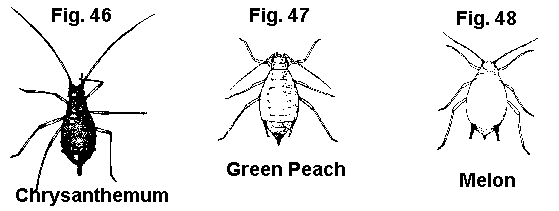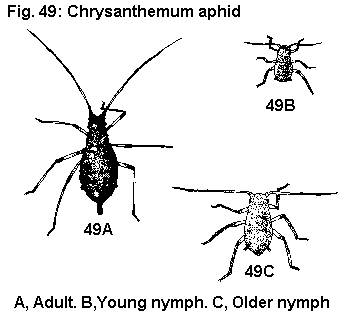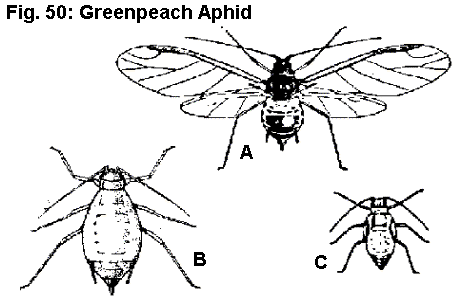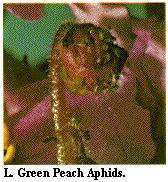Key to Aphids Found on Flowers and Foliage
- Aphid dark mahogany brown; found exclusively on chrysanthemum (Figure 46) - CHRYSANTHEMUM APHID
Aphid pale yellow, green, pink, or red; may be found on chrysanthemum but occur on other plants as well - GO TO 2 - Cornicles long, slender, and pale in color but sometimes dark at the tip; body 2 mm long (Figure 47) - GREEN PEACH APHID
Cornicles shorter and uniformly dark; body 1 to 1.8 mm long (Figure 48) - MELON OR COTTON APHID
Chrysanthemum Aphid
Chrysanthemum aphid (Figure 49), Macrosiphoniella sanborni (Gillette), Aphididae, HOMOPTERA
DESCRIPTION
Adult
The winged adults are about 2 to 2.5 mm long; soft bodied; and dark, shining mahogany brown. Due to their dark color they were once called "blackflies." Wingless adults are only 1.5 mm long. Small, black, sturdy cornicles are found on the end of the body.
Nymph
Nymphs resemble smaller versions of the adult aphids (0.6 to 1 mm). Nymphs have a dull, brick-red bodies with relatively long legs and antennae. The cornicles are short and dark. The outer two-thirds of the legs and antennae are gray (young nymphs) to dark gray. Older nymphs have proportionally longer cornicles. Those destined to be winged adults have wing buds in the later instars.
BIOLOGY
Distribution
The chrysanthemum aphid is of East Asian origin, but is now found where chrysanthemums are grown outdoors as well as in greenhouses.
Host Plants
Chrysanthemum is the only known host for this aphid in North America, but it has been reported on a few related plants in Asia.
Damage
The chrysanthemum aphid feeds by piercing the plant surface with its threadlike mouthparts to suck out plant juices. They gather about the terminal buds and feed on the new growth. This feeding causes distorted growth and the leaves may be covered by the feeding aphids' honeydew and cast skins. Sooty mold may grow on the honeydew giving the leaves and stems a black appearance. Chrysanthemum aphids are able to transmit chrysanthemum vein mottle virus and chrysanthemum virus B.
Life History
Only female chrysanthemum aphids are known.
They reproduce by giving live birth to more females, without mating. Chrysanthemum aphids overwinter in greenhouses where they feed throughout the winter. During the warmer months they leave the greenhouses in search of new plants. They also may be moved about as plants are shipped or sold. When the winged female stage infests new plants, it usually starts feeding and producing live nymphs. Each female can produce four to eight young aphids per day.
Within about a week the new nymphs mature into wingless females which begin to bear young of their own. One aphid on a plant in a short time may build the population up to hundreds of individuals. As the plant becomes crowded, more and more of the offspring develop into winged females which in turn migrate to other plants to begin new infestations.
CONTROL
Infested plants in the greenhouse should be sprayed thoroughly when aphids are first noticed. On outdoor plantings natural enemies may control minor infestations. For specific chemical controls, see your county Extension agent or consult your state's pest management guide for the control of pests on ornamental plants.
Green Peach Aphid
Green peach aphid (Figure 50), Myzus persicae (Sulzer), Aphididae, HOMOPTERA
DESCRIPTION
Adult
The small adult green peach aphid is light to dark green or pink, with red eyes (Figure L). Three dark lines run down its back. Wings may or may not be present. The tobacco aphid is similar and can be either red or green.
Egg
Found only in the northern United States, the egg is black and shiny for the green peach aphid. The tobacco aphid has not been found to have an egg stage.
Nymph
The wingless nymph resembles the larger adult.
BIOLOGY
Distribution
The green peach aphid, also called the spinach aphid, was first described in Europe in 1776. It is a pest all over the world. In the 1940s, an aphid thought to be the green peach aphid was first found feeding on tobacco plants. In 1986, this aphid was recognized as a new species, the tobacco aphid. The tobacco aphid is found in the tobacco growing regions of the United States.
Host Plants
Green peach aphids have been collected from more than100 plants, including a wide variety of vegetable and ornamental crops. Spinach, potatoes, and peaches (the host on which eggs are laid) seem to be especially favored hosts. Tobacco aphids will be pests primarily on tobacco and closely related plants such as flowering tobacco and Nicotiana. It is probably not a major pest, but will feed on pepper and eggplant as well as cold crops such as turnips, kale, and collards.
Damage
Both aphids suck plant sap and contaminate the host with honeydew and cast skins. Some hospitals refuse to allow cut flowers in patients' rooms because of the mess by aphids. They are also the vectors of a number of plant viruses including tobacco, tomato, lettuce, dahlia, canna, and bee mosaics as well as tuber spindle, rugose mosaic, and leaf roll diseases of potato.
Life History
In the northern United States, green peach aphids overwinter as eggs, but in the Southeast, no eggs are laid. Instead, female aphids give birth to young females during the growing season. The reproductive capacity of green peach aphids has been described as "fantastic." High reproductive rate and resistance to pesticides make the green peach aphid a formidable pest in the greenhouse. Up to 30 generations per year may take place in this pest's southernmost range. Ladybugs, lacewings, syrphid flies, damsel bugs, wasps, and parasitic fungi tend to regulate green peach aphid populations outdoors. Rain, wind, and mud also help check aphid populations outside.
The tobacco aphid probably overwinters on weed hosts or on cole crops that remain alive through the winter. Tobacco aphids are not known to have an egg stage, and they reproduce by giving birth to live young female aphids without mating. Their young are able to produce young as well without mating. If the plant becomes too crowded or if it becomes late in the season and the aphids need to find a winter host, the aphids give birth to young that will grow up to have wings and can move to other plants. Differences on reproductive rates exist between the red and green forms of the tobacco aphids. The red form is able to reproduce much faster during extremely hot weather than the green form.
On chrysanthemums, green peach aphids feed on all parts of the plant (melon aphids feed only on the buds and leaves, and chrysanthemum aphids feed only on the stems and leaves). Green peach aphids will not become established in the presence of the other two aphids unless pesticides are applied. In that case, green peach aphids outlive both melon aphids and chrysanthemum aphids.
CONTROL
Because green peach aphids overwinter on weed hosts, infestations can occur in the greenhouse any time of year. Green peach aphids readily infest bedding plants and can be introduced into greenhouses whenever bedding plants are brought in from another grower. Although damage per aphid is often not serious, these aphids reproduce so rapidly that serious harm can be done in a short time. Moreover, these aphids' resistance to pesticides calls for thorough applications whenever a new infestation is found. Tobacco aphids can be controlled in the same manner as green peach aphids. For specific chemical controls, see your county Extension agent or consult your state's pest management guide for the control of pests of ornamental plants.
Melon or Cotton Aphid
Melon or cotton aphid, Aphis gossypii Glover, Aphididae, HOMOPTERA
DESCRIPTION
Adult
This is a small aphid, smaller than most other aphids. The winged adults are about 1.25 mm long, soft bodied, and yellow to dark green with a black head and thorax. The wings are held rooflike over the abdomen at rest. Wingless adults tend to be 1 to 1.5 mm long, uniform in color, and yellow to dark green. The antennae and cornicles are shorter than those of winged adults. Cornicles are small, tail-pipe-like structures on the end of the body. Pale individuals tend to be smaller and to have fewer antennal segments than dark individuals.
Nymphs
Nymphs resemble adult aphids except for size (about 0.5 to 1 mm long). Those destined to be winged adults have wing buds in the later instars.
BIOLOGY
Distribution
The melon aphid is apparently distributed throughout the tropic, subtropic, and temperate zones of the world. It is more of a problem in the southern portions of the United States.
Host Plants
Melons and other cucurbits, okra, hops, strawberries, beans, spinach, tomatoes, clover, asparagus, citrus, catalpa, violet, hydrangea, begonia, ground ivy, and weeds are some melon aphid hosts. They have been discovered feeding on plants in 25 plant families. The melon aphid is an important pest of cotton and is also called the cotton aphid.
Damage
The melon aphid feeds by piercing the plant surface with its threadlike mouthparts to suck out plant juices. This feeding causes distorted growth, decreased yield, reduced quality of yield, and prematurely ripened fruit. The fruit may be covered by the feeding aphids' honeydew and by cast skins.
The melon aphid transmits several important plant viruses including cucumber mosaic, onion yellow dwarf, citrus quick decline, lily symptomless diseases, and lily rosette.
Life History
The melon aphid is an important pest of both agricultural and ornamental plants. Being practically omnipresent, it feeds upon many host plants. The melon aphid spends the winter on weed hosts and on cold-tolerant plants probably both as nymphs and adult females in the South. During warm periods of winter they start feeding until cold weather inactivates them again. In the spring the adult females move to new hosts and start feeding and rapidly reproducing. In northern climates the aphid overwinters in the egg stage. Indoors and in greenhouses the aphids feed and reproduce throughout the winter. Melon aphids commonly start out on one plant and spread out from that point. On woody ornamentals such as gardenias, feeding is confined to new growth in the spring.
For the melon aphid there are two kinds of hosts, primary and secondary. In late fall, aphids feed upon primary plants mate and lay overwintering eggs. Melon aphids feeding on secondary plants always give birth to live young. In spring, twenty-one winged forms usually infest new plants, both primary and secondary, and the females produce live nymphs. Within about a week the new nymphs mature into wingless females that begin to bear young of their own. As the plant becomes crowded, more and more of the offspring develop into winged females which in turn migrate to other plants to begin new infestations.
CONTROL
Syrphid fly maggots and ladybird beetles and their larvae feed upon melon aphids. Braconid wasps parasitize the aphids, and ants feed on the honeydew excreted by feeding aphids.
Because the winged forms are 2 to 3.7 times more resistant to organophosphate pesticides than are wingless forms, infested plants in the greenhouse should be sprayed thoroughly when aphids are first noticed. Wingless forms usually predominate in low aphid populations. On outdoor ornamentals natural enemies may control minor infestations. For specific chemical controls, see your county Extension agent or consult your state's pest management guide for the control of ornamental plants.
Publication date: Jan. 1, 1994
AG-136
Other Publications in Insect and Related Pests of Flowers and Foliage Plants
- Aphids Found on Flowers and Foliage
- Beetles Found on Flowers and Foliage
- Bugs Found on Flowers and Foliage
- Caterpillars Found on Flowers and Foliage
- Flies and Maggots Found on Flowers and Foliage
- Leafhoppers Found on Flowers and Foliage
- Mealybugs Found on Flowers and Foliage
- Mites Found on Flowers and Foliage
- Scale Insects Found on Flowers and Foliage
- Slugs and Snails Found on Flowers and Foliage
- Thrips Found on Flowers and Foliage
- Whiteflies Found on Flowers and Foliage
N.C. Cooperative Extension prohibits discrimination and harassment regardless of age, color, disability, family and marital status, gender identity, national origin, political beliefs, race, religion, sex (including pregnancy), sexual orientation and veteran status.




